What is beef yakisoba? Yakisoba is a Japanese stir fry dish made with ramen-style noodles, chopped veggies, and meat. This comforting dish is then flavored with yakisoba sauce, a sweet and savory condiment with similarities to Worcestershire sauce. In this healthy beef yakisoba recipe, I’m using rice noodles, lean strips of steak, piles of veggies, and a sugar free yakisoba sauce. You’ll love this spin on authentic beef yakisoba because it is healthier while remaining delicious!
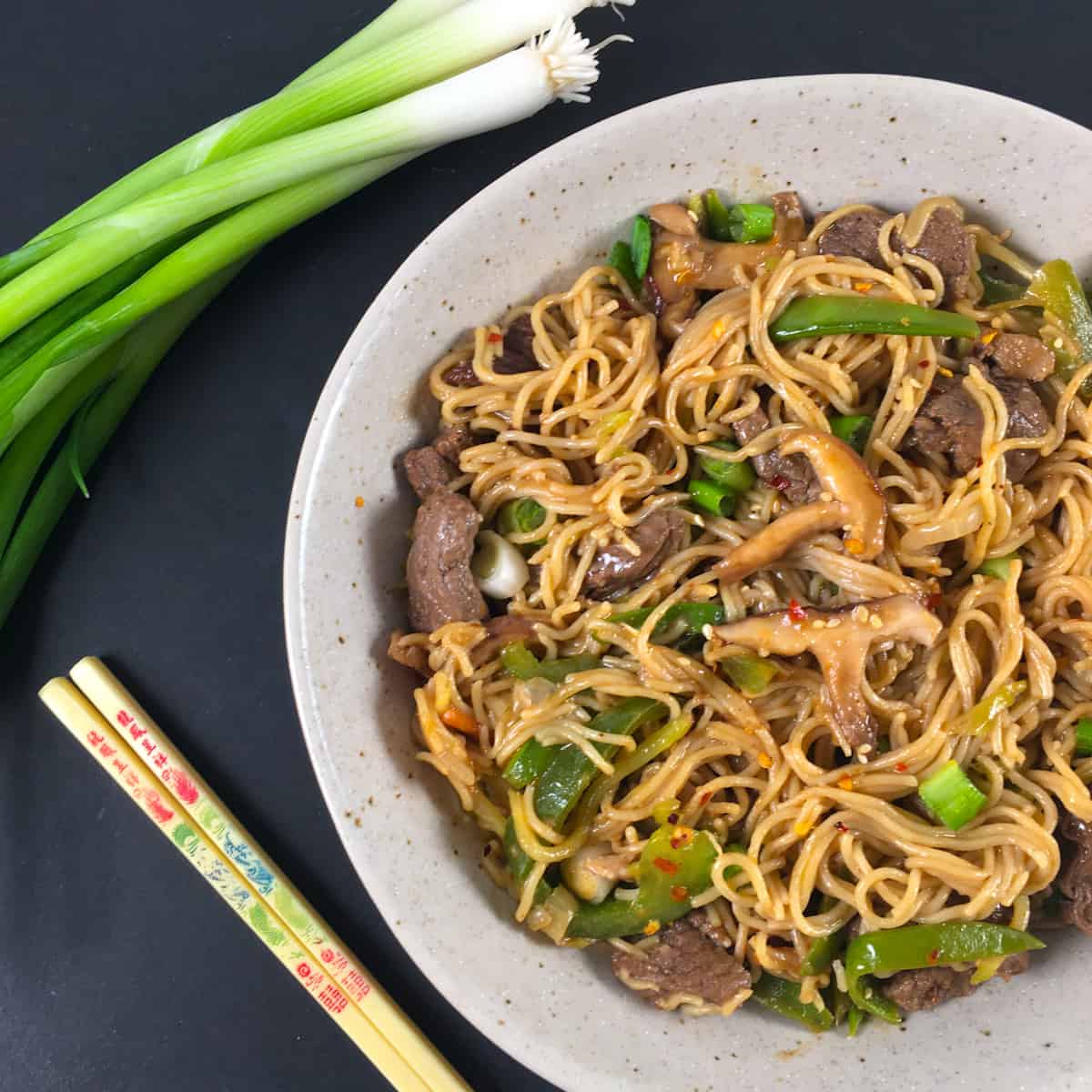
Yakisoba is the Japanese term for “fried soba” or “fried buckwheat noodles.” However, the dish yakisoba is typically made with Chuka soba (a Chinese wheat flour noodle) rather than a buckwheat noodle. In this recipe, I’ll be using gluten free ramen noodles made of millet and rice.
What counts as an authentic beef yakisoba recipe to you will depend on what you are accustomed to. Everyone puts a slightly different spin on this Japanese street food. I’ve even seen low carb and keto yakisoba using shirataki or zucchini noodles!
Perhaps you’re in Canada and most familiar with beef yakisoba from Edo Japan. Edo’s version of this noodle dish has beef, broccoli, mushrooms, cabbage, and carrots topped with the house teriyaki sauce.
Or if you’re from the western U.S., maybe you’ve tried beef yakisoba from Kabuki Japanese restaurant. Kabuki pairs thinly sliced beef and noodles with a mélange of cabbage, onions, and bean sprouts. Yum!
Many of us though (particularly in the U.S.) may be most familiar with Maruchan yakisoba. Plastic packages of inexpensive ramen noodles with dry seasoning packets tend to be popular with college students. If this is what yakisoba means to you, let me show you why homemade beef yakisoba is better!
Jump to:
Why is this the BEST beef yakisoba recipe?
Why make this recipe when those microwave beef teriyaki yakisoba containers are so convenient? Well, here are a few reasons for you:
- Easy and delicious: This quick beef yakisoba comes together entirely on the stovetop, so it doesn’t take too much effort. Plus, I think you’ll find it’s way tastier than microwave ramen. The additional work is definitely worth it!
- Whole grains: Unlike most beef yakisoba recipes, this dish uses whole grain ramen noodles. Check out the “ingredients” section below if you want to learn more about them. Whole grains contain fiber and additional nutrients that tend to be lacking in refined grains.
- No added sugar: This healthy yakisoba recipe has no added sugar, unusual for a dish of this type! The only kind of sugar here is the type naturally occurring in the vegetables (and some of the other ingredients).
- Extra veggies piled in: I loaded this dish with lots of colorful veggies and shiitake mushrooms. If you’re looking to eat more veggies for health, I’ve got you covered with this one. (The veggies make the dish more colorful and pleasing to the eye as well, IMVHO.)
- Plenty of high-quality protein: Beef plays a starring role in this dish, adding protein plus highly bioavailable iron and zinc. If you’d like a vegan or vegetarian version using “real foods,” try substituting the beef for chunks of seasoned tofu. (FYI, my personal definition of “real food” is foods that are not ultra-processed.)
Beef Yakisoba Ingredients
Wondering what you need to make beef yakisoba? Here’s what I used for this delicious noodle recipe:
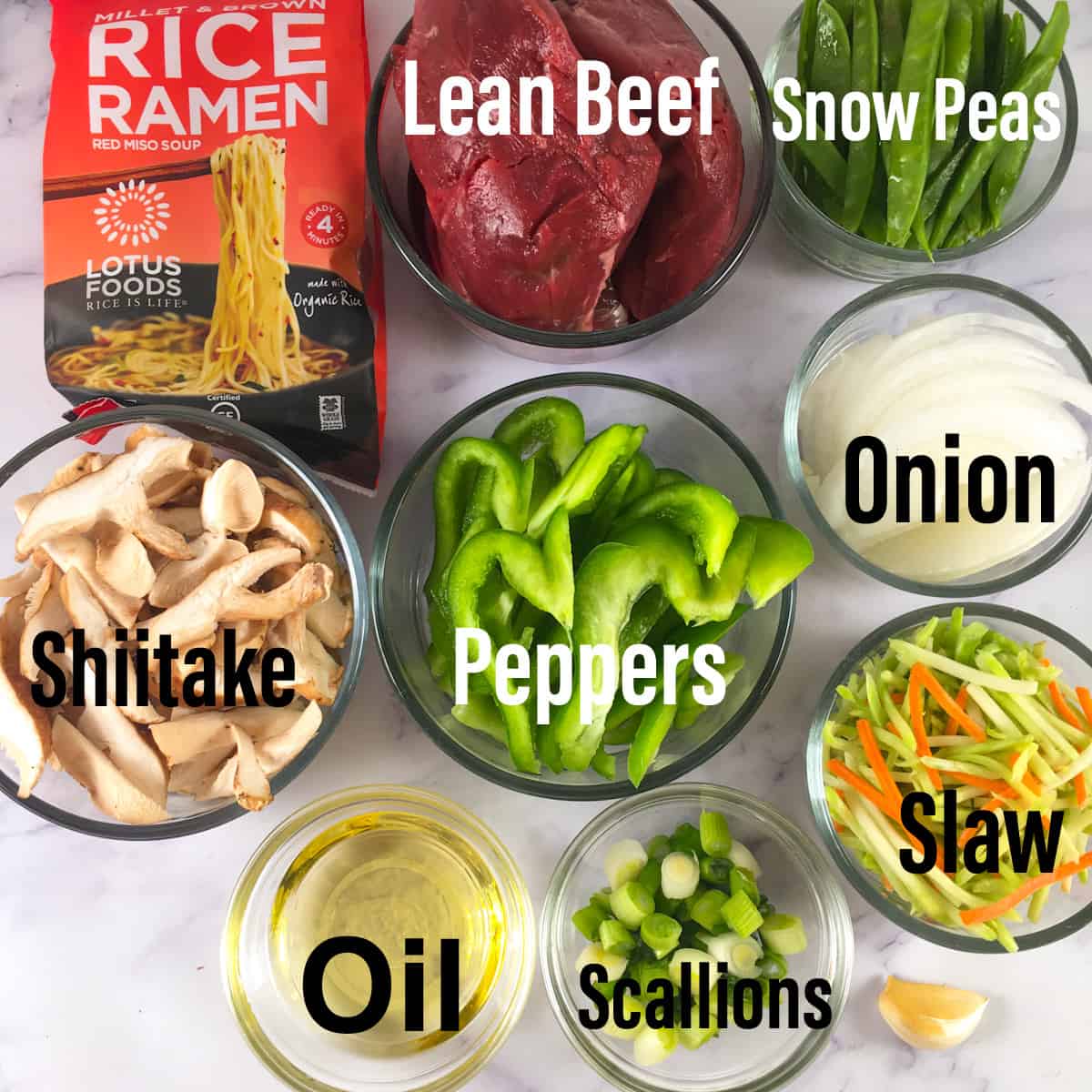
- Lean beef, cut into strips
- Black pepper
- Olive oil or avocado oil
- Sliced white onion
- Minced garlic
- Sliced green pepper
- Sliced snow peas
- Broccoli slaw mix
- Sliced shiitake mushrooms
- Noodles
Cabbage, carrots, onions, and bean sprouts are often used in yakisoba recipes. If you’d rather not use the broccoli slaw, you could try a cabbage-based coleslaw mix instead. Other veggies, like kale, broccoli, and cauliflower could also work here.
It was a little tricky to find a whole grain noodle good for yakisoba. I ended up using gluten free Lotus Foods Millet and Brown Rice Ramen. These noodles are heartier than regular rice noodles making them a good substitution for yakisoba noodles (which are usually made with wheat).
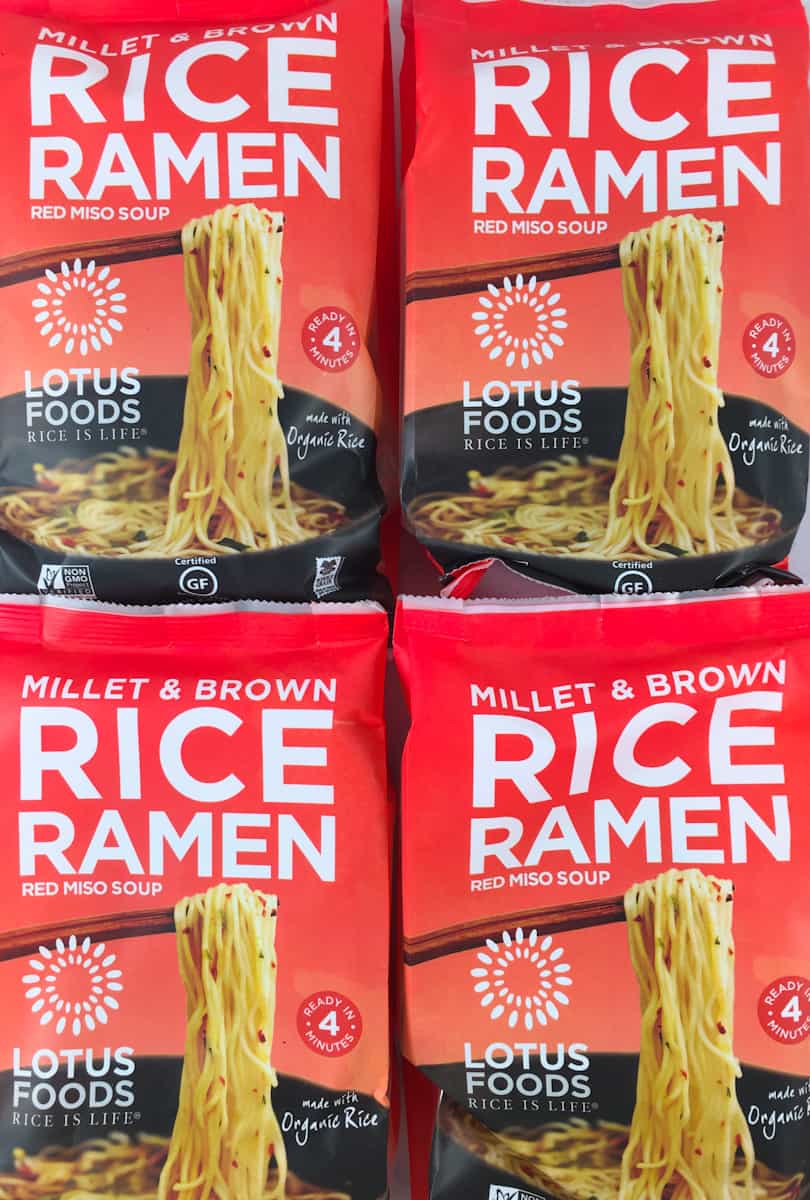
The noodle packets I purchased came with red miso seasoning packets which I did not use here. The only ingredients in the rice noodles themselves are brown rice flour and millet flour.
An 80-gram portion of the noodles provides 4 grams of fiber and 8 grams of protein. This is far more fiber and protein than you’ll find in most white flour noodles.
Beef Yakisoba Garnishes
Yakisoba is typically served with a variety of garnishes. Here are some common toppings:
- Pickled ginger
- Oyster sauce
- Seaweed
- Bonito fish flakes
- Toasted sesame seeds
- Crushed red pepper flakes
- Sliced scallions
I used scallions, sesame seeds, and pickled ginger on our plates. The pickled ginger was an especially flavorful addition.
You’ll also need a pot to cook the noodles and a wok for stir frying the ingredients. If you don’t have a wok, another wide and flat sauté pan should also work well.
Beef Marinade for Yakisoba Ingredients
I actually did not use a beef yakisoba marinade, but I did make a sauce for this stir fry noodle dish. I think with the flavorful sauce, you don’t need to marinate the beef.
Most recipes for beef yakisoba sauce contain Worcestershire sauce and ketchup, both ingredients with added sugar. Skipping the Worcestershire and using a no added sugar ketchup makes my version refined sugar free. Even without the Worcestershire, there is still plenty of umami flavor from soy sauce, mushrooms, and other ingredients in the dish.
What You Need to Make Sauce for Beef Yakisoba
I already told you about the main ingredients for the stir fry. However, you’ll also need a few more things for the sauce. Here’s the roundup:
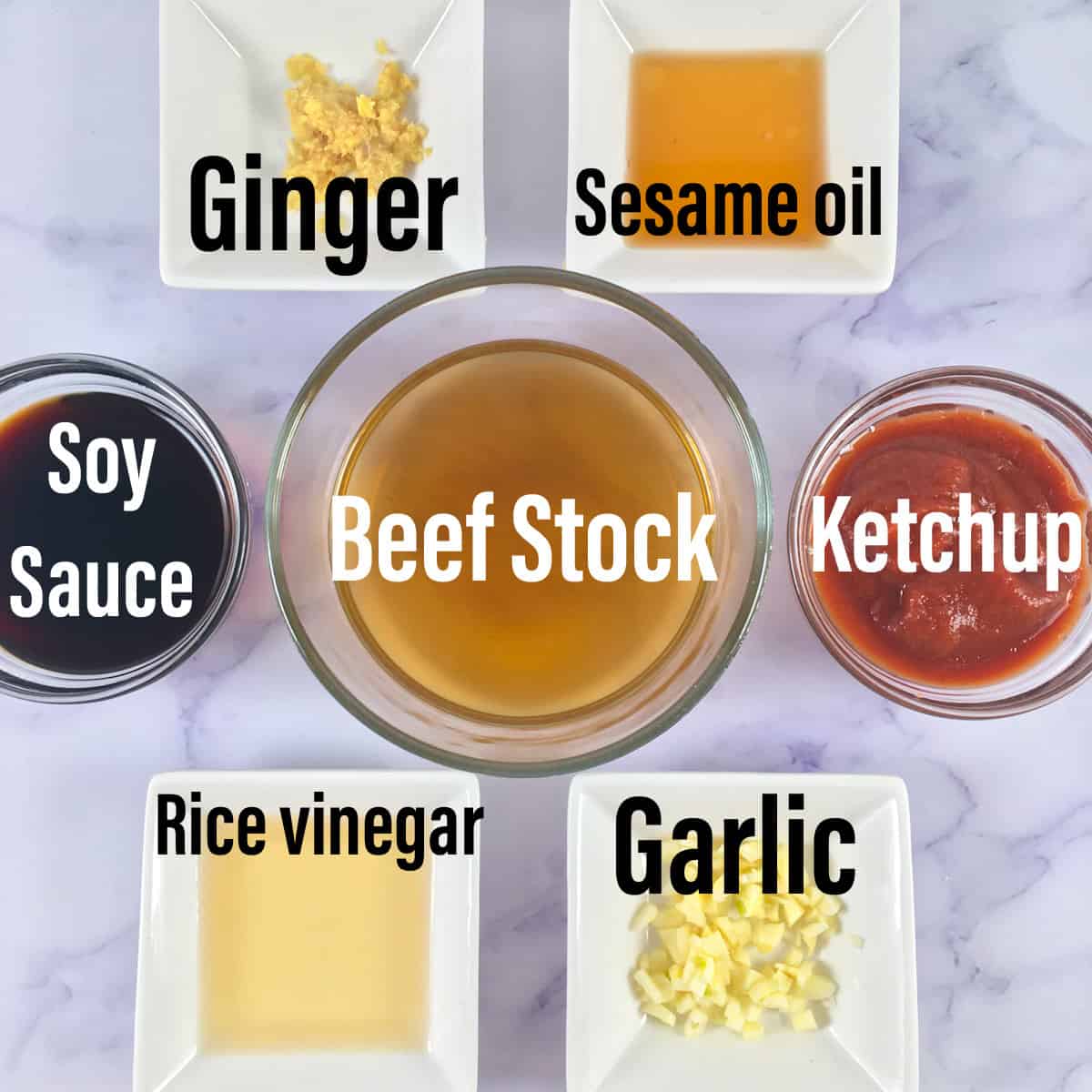
- Beef stock (homemade is best)
- Ketchup with no sugar added
- Rice vinegar (not seasoned rice vinegar)
- Low-sodium soy sauce
- Grated ginger root
- Finely chopped garlic
- Toasted sesame oil
Beef stock is my preference here, but you can substitute with vegetable broth if you prefer. For the ketchup, I prefer True Made Foods Vegetable Ketchup. It gets natural sweetness from fruit and vegetable purees, so no added sugars or sugar substitutes are used.
What type of beef for yakisoba?
Lean cuts of beef such as sirloin, flank steak, or skirt steak are the best choices for beef yakisoba. For the best results, cut the beef into thin strips against the grain. (FYI- I did not do this, but it is a must if you use flank or skirt steak.)
All of the above said, I used a different cut of beef. (I lucked out getting some nice steaks on sale!) It’s fine to tweak this recipe to use what you have.
How to Make Beef Yakisoba
Let’s do this! Start by slicing your vegetables and cutting the beef into strips. Make the sauce by whisking the stock, ketchup, vinegar, soy sauce, ginger, garlic, and sesame oil together. Once we get cooking, things move fast!
Set a medium-sized pot of water to boil over medium heat. We’ll need it later for the noodles.
Heat some oil in a wok over medium-high heat. Sprinkle the beef with black pepper. Brown the beef in the wok, stirring frequently. This took approximately 4-5 minutes. Set the beef aside.
Wipe out the wok (if needed) and heat a little more oil over medium-high heat. Add all of the vegetables and the shiitake mushrooms.
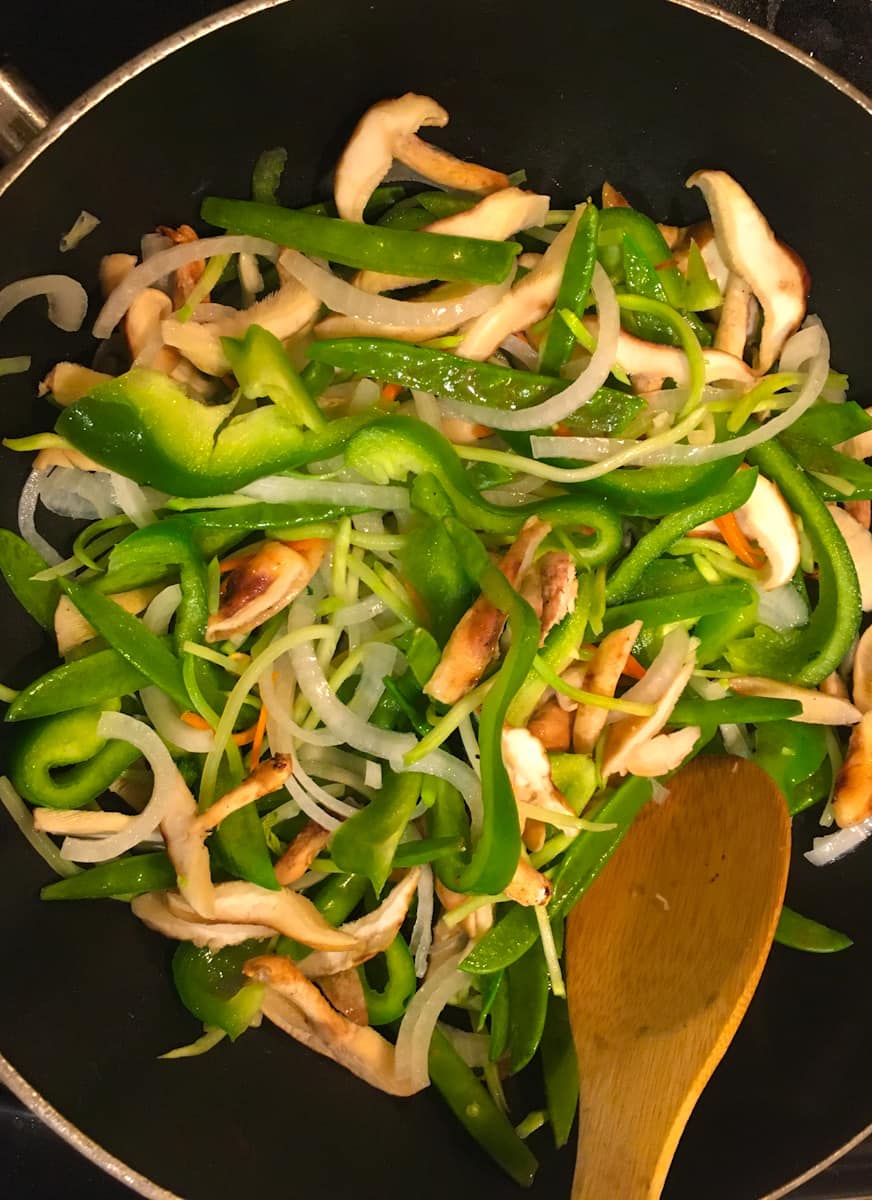
Stir fry the veggies for 3-4 minutes and then add the beef back to the wok.
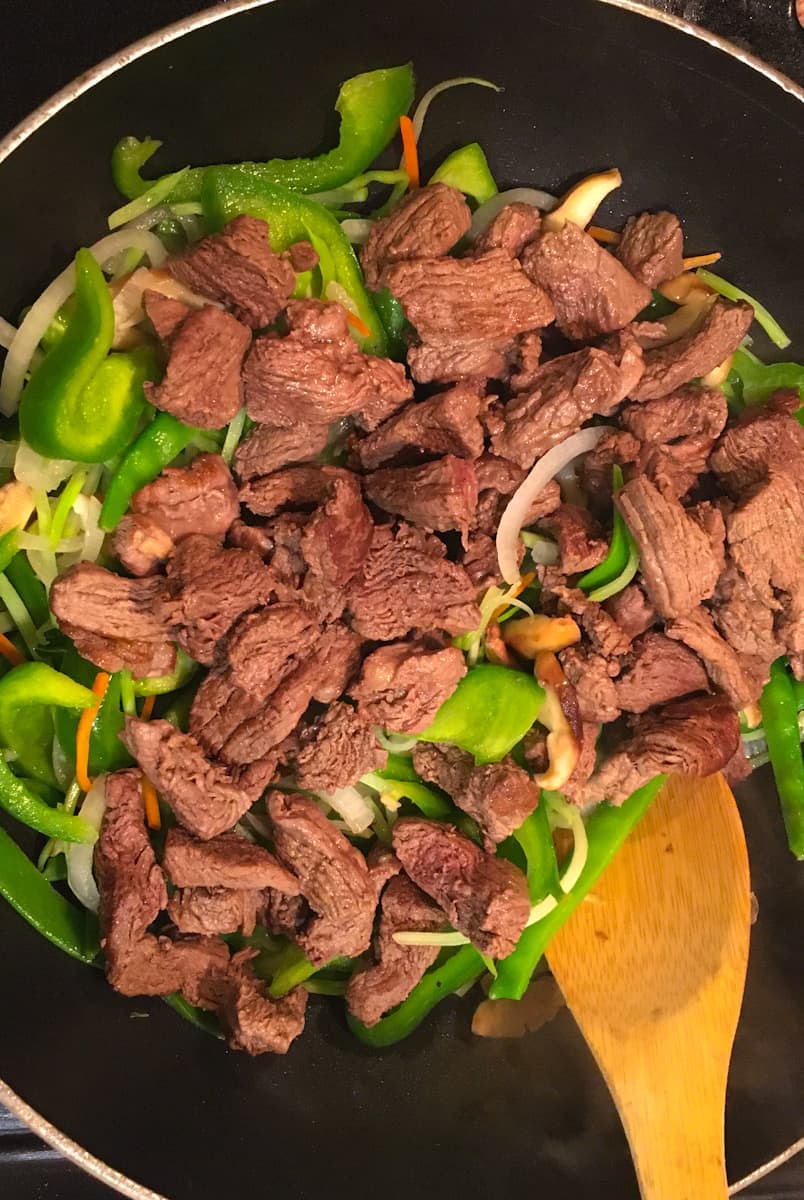
When the water is boiling, add the noodles to the pot. Cooking times will vary depending on the noodles you use. Check the package of the product you buy to get the timing right.
The millet rice noodles I used took four minutes to cook. Break the noodles up with a fork towards the end of the cooking time if they’re sticking together. (This is more likely to happen with blocks of ramen noodles.)
Be sure to thoroughly drain the noodles right after cooking. It’s important not to overcook them. You don’t want to end up with a pile of noodle mush.
Add the cooked noodles and sauce to the wok. Turn the stovetop heat to high and stir frequently, letting everything absorb most of the sauce. This should take no more than 2-3 minutes.
That’s it! Garnish your beef yakisoba and serve immediately. You’re in for a treat!
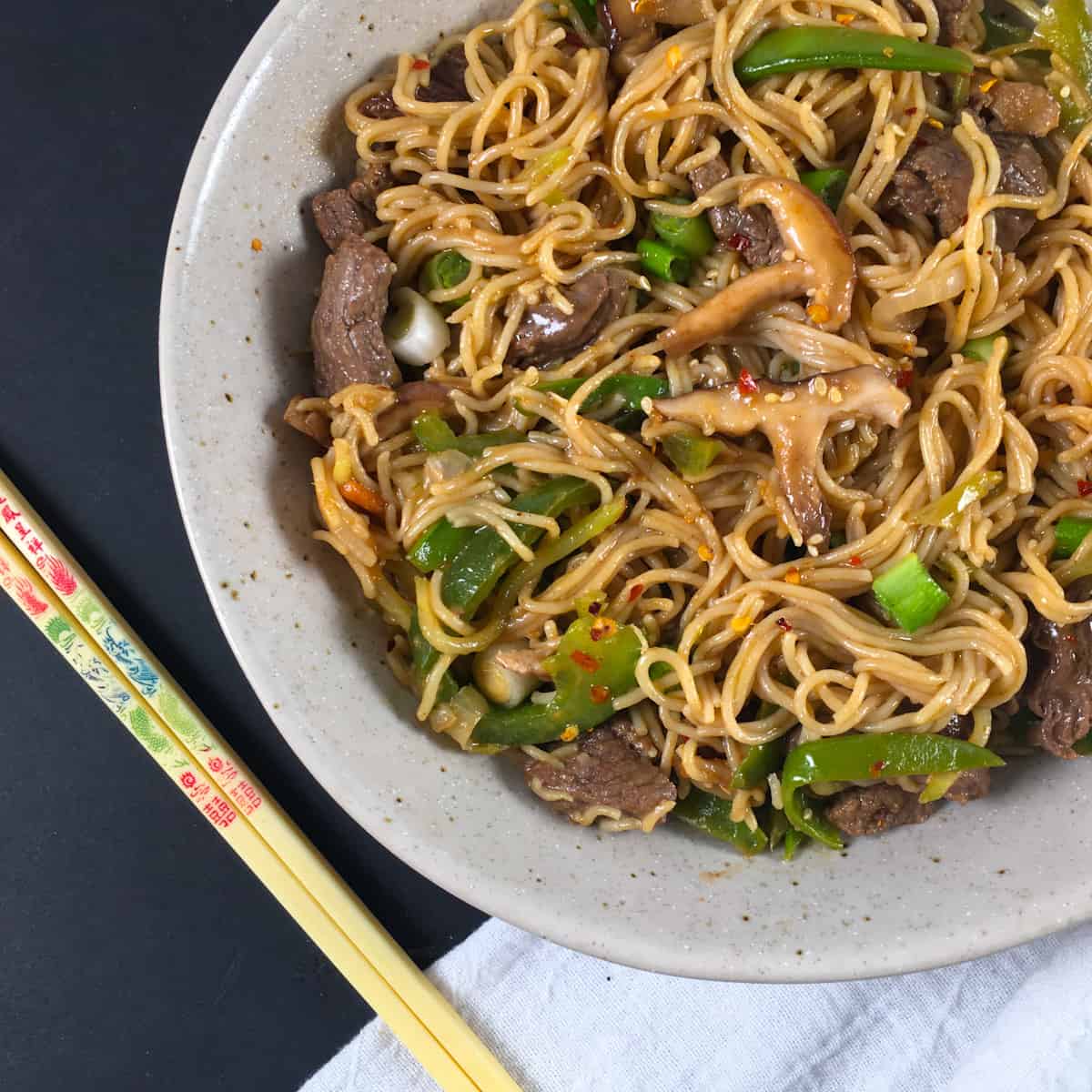
It’s true this healthier beef vegetable yakisoba recipe isn’t “authentic.” I can say, however, that it is authentically Summer. Haha
Leftover Beef Yakisoba
IMVHO, this dish isn’t great as leftovers because the noodles begin to stick together. In other words, I wouldn’t use this recipe as a meal prep.
If you’d like to make this recipe ahead of time, stir fry the beef and veggies together and make the sauce. When it is time to serve, cook the noodles, add to the reheated beef and veggies, and stir in the sauce (on the stovetop). Using freshly cooked noodles makes a world of difference to the texture of this dish.
Expert Tips from a Dietitian
This is a level 3 recipe (weight maintenance and active lifestyles). This healthier beef yakisoba gets the bump to level 3 due to the presence of flour (in the noodles). Believe it or not, over half the calories in this dish are coming from the noodles. You are getting 325 calories just from noodles with each serving of this one!
Does this surprise you? Many people aiming to “eat healthier” to lose weight drop the beef from this dish while leaving (or increasing!) the whole grain noodles. I believe this is a mistake for two reasons:
- The lean beef is the main source of PROTEIN in this meal. Protein can help you to feel full, so that you’re less likely to graze between meals. Depending on the cut of beef you use, the reasonable portion here only provides 150-180 calories per serving.
- Regardless of whether you prefer low carb, counting points, directly tracking calories, etc. you must be in a calorie deficit to lose weight. Piling on the noodles also piles on the calories without providing a lot of protein or volume to meals. Adding more non-starchy vegetables in place of the noodles will keep the fiber you would get from whole grains for far fewer calories.
Luckily, it’s really easy to make a low calorie beef yakisoba recipe. Simply use shirataki or spiralized squash in place of the noodles. This swap is also a great way to make this yakisoba low carb (and perhaps keto).
What are some other healthy beef recipes?
If beef’s what’s for dinner, you’ve come to the right place! I have lots of healthy recipes using beef for you to check out. After you make this recipe for beef yakisoba, why not try one of these:
Frequently Asked Questions
How many calories does beef yakisoba have?
The calories in beef yakisoba will vary based on the size of your portion and the ingredients you use. This healthy pan fried noodles recipe has 611 calories per serving (¼ of the recipe).
Maruchan Yakisoba has 500 calories per container. (They call the container two servings, but realistically most will treat it as a single serving.) Even though it is higher in calories, the homemade yakisoba is still the better choice because it is more nutrient dense.
How do Japanese home cooks make yakisoba?
Here’s a simple authentic Japanese yakisoba from a food blogger in Japan. It has pork belly, so you know it’s got to be delicious!
Can you make beef yakisoba with spaghetti noodles?
Yes, you can use spaghetti noodles in this beef yakisoba recipe. Traditional yakisoba noodles (Chuka soba) or bricks of ramen noodles would also work. (Just make sure to discard the seasoning packets if using ramen noodle bricks.)
What are the differences between ramen, udon, and soba?
“Ramen” commonly refers to a Japanese noodle soup. It has a rich and savory broth, Chinese-style wheat or egg noodles, plus meat and veggies. Ramen noodles tend to be long, thin, and springy.
In the U.S., “ramen” often evokes a just-add-water microwave meal made with thin noodles sold in a hard brick with a salty seasoning packet. (Yup, the homemade version is definitely the more nutritious option!)
Udon are thick and chewy wheat noodle from Japanese cuisine. Udon can be used instead of ramen or Chuka soba in this dish. If you make this substitution, it may be more correct to call your dish yaki udon.
Another type of Japanese noodle is soba. Soba is a buckwheat flour noodle, though sometimes wheat flour is also added, so it isn’t necessarily gluten free. You can also make this beef yakisoba with soba noodles if you’d prefer.
Can you make beef yakisoba in an instant pot?
You could make this an instant pot beef yakisoba recipe by using the instant pot’s “sauté” function instead of a wok. Don’t put the lid on while it cooks, and be sure to stir regularly (as you would on the stovetop). I still recommend cooking the noodles separately on the stovetop before adding to the beef and veggies.
How do you make beef yakisoba gluten free?
Make this beef yakisoba without gluten by swapping the soy sauce for gluten free tamari or coconut aminos. Many yakisobas use Worcestershire sauce (which may contain gluten) and wheat noodles (which always have gluten). With this recipe, you only need to swap the soy sauce for gluten free beef yakisoba.
Can I make beef yakisoba with ground beef?
Yes, you can! As an added bonus, using ground beef in yakisoba will probably be cheaper for you than using steak.
You can substitute ground beef for the steak in this recipe. Instead of browning steak strips, brown ground beef crumbles and set them aside. Add the cooked beef mince back to the wok after stir frying the veggies, just as you’d do with the steak.
Other Easy Stir Fry Dinners for You to Enjoy
Stir fries are a great way to get healthy food on the table fast! After trying my beef yakisoba, here are some other healthy stir fry recipes for you to check out:
Don‘t forget to subscribe to our Weekly Newsletter to be kept up-to-date on all of the latest and greatest recipes! You can follow me on Pinterest, Twitter, and Instagram!
And now for the disclaimer…
All recipes on this website may or may not be appropriate for you, depending on your medical needs and personal preferences. Consult with a registered dietitian or your physician if you need help determining the dietary pattern that may be best for you.
The nutrition information is an estimate provided as a courtesy. It will differ depending on the specific brands and ingredients that you use. Calorie information on food labels may be wildly inaccurate, so please don’t sweat the numbers too much.
For more information on how the three recipe levels may help with a weight management goal, refer to my overnight oats with yogurt post. Let’s get cooking!
 Recipe
Recipe
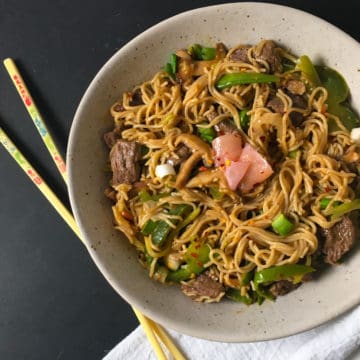
Beef Yakisoba (Healthy, No Sugar Added!)
This healthy beef yakisoba recipe uses rice noodles, lean strips of steak, piles of veggies, and a sugar free yakisoba sauce. SO GOOD!
Ingredients
- 1 lb. sirloin, flank steak, or skirt steak (cut into thin strips)
- black pepper, to taste
- 5 teaspoons avocado oil (divided)
- 1 clove garlic, minced
- ½ cup white onion, sliced
- 1 medium green pepper, sliced
- ½ cup snow peas, sliced in half lengthwise
- 1 cup broccoli slaw
- 3.5 ounces shiitake mushrooms, sliced
- 14 ounces millet and brown rice ramen noodles, dry (or use your favorite noodles for yakisoba)
- pickled ginger, sliced scallions, toasted sesame seeds, crushed red pepper flakes (optional; for garnish)
To make the beef yakisoba sauce:
- 6 tablespoons beef stock
- ¼ cup no added sugar ketchup
- 1 tablespoon rice vinegar
- 3 tablespoons low-sodium soy sauce
- 1 teaspoon fresh grated ginger
- 2 cloves garlic, finely chopped
- 2 teaspoons toasted sesame oil
Instructions
-
Slice the vegetables and mushrooms. Cut the steak against the grain into thin strips. Sprinkle the steak with black pepper.
-
Whisk the stock, ketchup, vinegar, soy sauce, ginger, garlic, and sesame oil together. Set this sauce aside.
-
Set a medium-sized pot of water to boil over medium heat. You’ll need it later to cook the noodles.
-
Heat 2 teaspoons of oil in a wok over medium-high heat. Brown the beef in the wok, stirring frequently. This took approximately 4-5 minutes. Set the beef aside.
-
Carefully wipe out the wok (if needed) and heat the last 3 teaspoons of oil over medium-high heat. Add all of the vegetables and the shiitake mushrooms. Stir fry the veggies for 3-4 minutes. Add the beef back to the wok.
-
When the water is boiling, add the noodles to the pot. Cooking times will vary depending on the noodles you use. Check the package of the product you buy to get the timing right. The millet brown rice noodles I used took 4 minutes.
-
Gently break the noodles up with a fork towards the end of the cooking time if they are sticking together. Thoroughly drain the noodles when they are finished cooking.
-
Add the cooked noodles and the sauce to the wok. Turn the stovetop heat up to high and stir frequently, letting everything absorb most of the sauce. This should take no more than 2-3 minutes.
-
Garnish as desired and serve.
Video
Notes
This is a level 3 recipe (weight maintenance and active lifestyles). This healthier beef yakisoba gets the bump to level 3 due to the presence of flour (in the noodles). Believe it or not, over half the calories in this dish are coming from the noodles. You are getting 325 calories just from noodles with each serving of this one!
Does this surprise you? Many people aiming to “eat healthier” to lose weight drop the beef from this dish while leaving (or increasing!) the noodles. I believe this is a mistake for two reasons:
- The lean beef is the main source of PROTEIN in this meal. Protein can help you to feel full, so that you’re less likely to graze between meals. Depending on the cut of beef you use, the reasonable portion here only provides 150-180 calories per serving.
- Regardless of whether you prefer low carb, counting points, directly tracking calories, etc. you must be in a calorie deficit to lose weight. Piling on the noodles also piles on the calories without providing a lot of protein or volume to meals. Adding more non-starchy vegetables in place of the noodles will keep the fiber you would get from whole grains for far fewer calories.
Luckily, it’s really easy to make a low-calorie beef yakisoba recipe. Simply use shirataki or spiralized squash in place of the noodles. This swap is also a great way to make this yakisoba low carb (and perhaps keto).
Nutrition information is for one serving of the recipe and does not include the optional garnishes.
Nutrition
Calories: 611kcalCarbohydrates: 71.8gProtein: 37.6gFat: 16.9gSaturated Fat: 3gPotassium: 637.4mgFiber: 7.6gVitamin A: 20% DVVitamin C: 71.2% DVCalcium: 10.7% DVIron: 30.6% DV
source https://betterweightloss.info/beef-yakisoba-healthy-no-sugar-added/


No comments:
Post a Comment